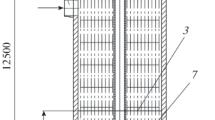Conclusions
The reactor tests of fuel elements with heat-exchange intensifiers, operating with full evaporation of the water, with superheated steam, and without the use of an intermediate separator, shows that it is possible in principle to design a single-pass steam generator in reactors with tubular fuel elements.
The operations for regulating the parameters in the steady-state regimes have been worked out, and the nature of variations in the heat-engineering parameters under transient conditions has been studied.
During the tests (125 days for channel 2) no significant variations in the temperatures of the fuel elements were observed, which directly confirmed the absence of any marked deposition due to boiling on the heat exchange surfaces (even when using relatively poor quality water).
It has been established that the fluctuations in reactor power within the dead zone of the power regulator give rise to instabilities in the temperature regime of the fuel elements. Under these circumstances, the temperature fluctuations in the transition zone of heat transfer are significant. To reduce these fluctuations in fuel element temperature in the transition zone, we should reduce the dead zone of the power regulator, use fuel elements of lower power for the part of the evaporation channel containing the heat-transfertransition zone, and increase the heat transfer to steam by increasing the mass flow in the fuel elements within the transition zone. Just these measures alone can reduce the amplitude of the fluctuations of fuel element temperature to a safe level.
In our opinion, bearing in mind all the limitations of the experiments, the results achieved are of interest for assessing the prospects of single-pass steam generators in power reactors. The absence of traditional equipment in the form of drum separators and circulating pumps, which are difficult and expensive to manufacture, to a large extent simplifies the nuclear steam-generating plant, and reduces its cost.
Similar content being viewed by others
Literature Cited
V. I. Subbotin et al., Teploénergetika, No. 9, 24 (1974).
S. Mizshak, Progress Rep. No. 1, USA, EC, Rep. DP-380 (1959).
V. P. Babarin et al., Heat Transfer, Hydrodynamics and the Thermophysical Properties of Matter [in Russian], Nauka, Moscow (1968), p. 45.
É. K. Kalinin et al., Intensification of Heat Exchange in Channels [in Russian], Mashinostroenie, Moscow (1972).
V. K. Migai, Inzh.-Fiz. Zh.,22, No. 2, 248 (1972).
V. V. Dolgov et al., At. Énerg.,9, No. 1, 10 (1960).
B. A. Zenkevich et al., At. Énerg.,27, No. 5, 391 (1969).
Additional information
Translated from Atomnaya Énergiya, Vol. 41, No. 2, pp. 75–81, August, 1976.
Rights and permissions
About this article
Cite this article
Dolgov, V.V., Kozlov, V.Y., Minashin, M.E. et al. Experience in the operation of channels with single-pass steam generation in the reactor at the first nuclear power station. At Energy 41, 687–693 (1976). https://doi.org/10.1007/BF01132640
Received:
Issue Date:
DOI: https://doi.org/10.1007/BF01132640




